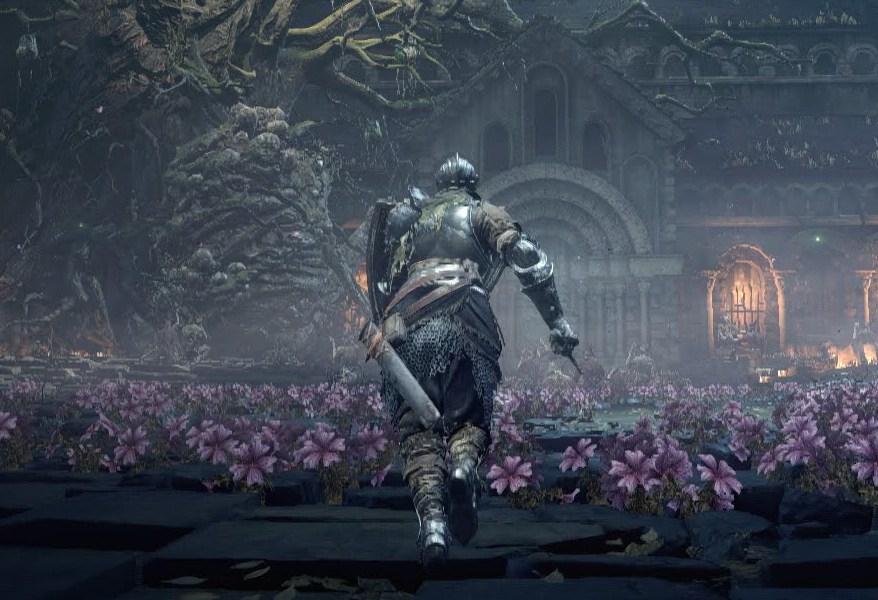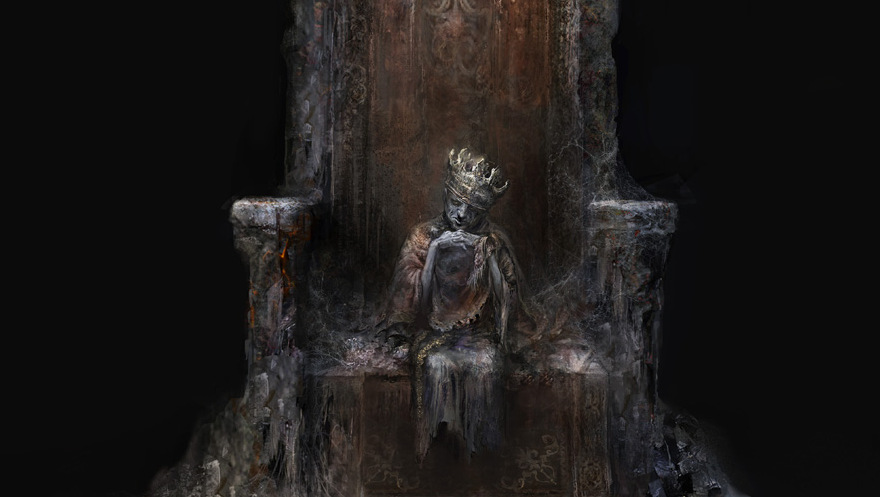You first encounter them in the Undead Settlement. It’s a moment of incongruous reprieve: having rolled and dashed your way through a hail of human-sized arrows and swarms of rake-wielding peasants, you come up a hill and into a dark, somber cathedral that all but invites you to stop and smell its flowers. With their violet hue and soft yellow centers, these delicate beauties scattered around the building seem more unlikely than any of the monstrosities you’ve been busy butchering. Dark Souls III’s kingdom of Lothric has, up to this point, largely displayed the same taste for earth tones favored by the depressive landscape architects of Lordran and Boletaria. You’re left to wonder at the explanation for this sudden infusion of color in the dreary wasteland of the settlement.
You can hazard some theories if you pay attention to your inventory. Dark magic is presented in a spectrum of purple, so that it can be distinguished from white lightning, flame, and the typically dark environs. Purple is the color of the items you use to relieve poison effects, and the color of the build-up bar for poison and other types of damage. And then there is one particularly duplicitous miracle—”Atonement”— illustrated in purple. Using this miracle earns you increased attention from your enemies; its description benignly encourages you to kiss their swords in the interest of forgiveness. Tempting offer—but what does it have to do with those flowers?

As you look closer in the hall’s wan light, you see that they are not sprouting from the stones themselves, but from a system of roots that have wedged themselves into the veins of the cathedral. When you follow the roots and the flowers multiply, your finely-tuned sense of imminence tautens. There’s something unpleasant at the end of this trail. And you wouldn’t be wrong, except that what you find behind the inevitable archway is also sort of comical—a scattering of Hollows, kneeled in worship before an enormous, anatomically suggestive tree. This is the Curse-Rotted Greatwood, one of Dark Souls III’s optional bosses. Pick a fight and you’ll find that it cares little for its faithful devotees, stomping all over them as it tries to prevent you from piercing its bulbous vulnerables.
The Greatwood, we learn, was a “spirit tree” sullied by locals desperate to seal away the curses that plagued them. Since they died, it presumably didn’t work. But this makes the religious rites a bit mysterious. Perhaps what these Hollows are praying for is atonement, and a benign sword to end their murderous subsistence. They might be imploring the mighty oak for greater power, and darker magics. Or maybe they are simply pleading for relief from the poison that—enacting nature’s revenge—it leaked into the soil they once tilled.
///
From this point on you play arboreal detective, delving progressively deeper beneath Lothric’s ashen surface in pursuit of the curses’ roots. You pass through the requisite poison swamp in Farron Keep, only this swamp—unlike Blighttown or the hellish Valley of Defilement from earlier entries in the Souls series—is actually not such a bad place to get bogged down. There are no flowers, only regally decaying leaves spotting the hills with bronze and crimson and pools of purple poison offsetting sickly tan stalks. It’s all rot and decay, but once again possessed of an unworldly beauty that speaks to something higher—or lower, in this case—at the fount of the dreck.
Finally, you hit rock bottom. All the toxic, earth-scorching curses emanate from a single room in a large cathedral, which puts a Romanesque spin on the Thicknesse-era Ministry of Magic. Here, you find no beasts or mighty lords—only a gaggle of ancient, withered clerics who give up the spirit rather indifferently. As you render their faded violet robes one by one, the deacons pass a radiant, purple light—a soul—back and forth between them like some unnatural beach ball. Hack one down, he bounces the ball along, sacrificing himself for the continuance of a heritage long corrupted.
It’s a brilliant image, and a fiendish variation on the principal theme of every Souls game: tradition and order can only be maintained at the cost of blood, and above all the blood of those who maintain it. To link the fire is to unite the polis, and no one here has the patience for a social contract. But those who held the power in earlier series entries were usually queens, knights, or monsters—here, the game’s most wide-reaching and perfidious evil is a particularly decadent strand of Catholicism. The story of this domination is, as with everything else in Hidetaka Miyazaki’s singular art, told elliptically and symbolically. It would be easy to miss altogether if you were solely focused on surviving. But this speaks to one of the qualities that distinguishes Dark Souls III, even from its venerable predecessors: the visual detail now conveys as much to the attentive eye as the series’ famous item descriptions always have to the curious mind.
So it is that when you follow the trail of those “Deacons of the Deep” to the lost city of Irithyll, you are greeted by the only other purple flowers found anywhere in the game. There are fewer this time, and it’s a different species, but that shade is unmistakable. It’s a reminder. This place is cursed, poisoned, sullied with sin. But also: this place is holy. If poison represents one end of the symbolic spectrum in this game’s use of purple, the other end belongs to the grandeur and beauty that the great ecclesiastical traditions of the Medieval period were capable of before their decline.

These two meanings converge in Irithyll, where you find that an order of priests has infested and overtaken a once-mighty, once-secular kingdom whose true name will be familiar to Souls veterans. Here we meet Pontiff Sulyvahn, a formidable pope who encourages his knights to use kamikaze tactics. And we meet Saint Aldrich of the Deep, a cannibal who may or may not be in the process of devouring The Dark Sun Gwyndolin when you meet him. “Aldrich” seems to derive from the Germanic name “Aldric,” which, in Old German, means “old power.” “Ric” would then be a distant cognate of “Reich.”
Miyazaki has previously explored themes of religious decline and oppression in Bloodborne (2015). But where the narrative of that extraordinary game is steeped in the anxieties of modernism, Dark Souls III keeps its feet firmly planted in the Middle Ages—specifically, if this part of the narrative is any indication, the Byzantine era. This relatively neglected period in western history overlaps with what self-aggrandizing Renaissance historians would call the Dark Ages, but Byzantium itself—known as Constantinople in the high years of its power, and now as Istanbul—was one of the most stable and intellectually rich empires in human history. It was also the first empire founded on the authority of the Christian church. Whatever the real connection between these facts, the Byzantine era is typically thought of now as a period of decline, slotted between the grandeur of the Roman Empire and the genius of the Renaissance. If we take Anor Londo as our Rome, Irithyll can then be seen as a mythologized version of what Byzantium represents to a modern historical consciousness.
Pontiff Sulyvahn and Saint Aldrich wear purple because it was the color of authority in this period of history. Coveted by Roman magistrates and emperors, it was adopted by the rulers and bishops of Constantinople and the Holy Roman Empire. The reason is simple—they were the only ones, in that time, who could afford it. Purple is a rare color in nature, and the only method of producing it in large quantities back then was costly and time-consuming. A particular type of mollusk that secretes a purple dye to sedate prey had to be captured and either “milked” or crushed to remove the dye. But since each shellfish only produces a tiny amount, the poor creatures had to be sacrificed en masse—12,000 mollusks for every 1.4 grams of dye, which was about enough for the lining on one garment. There was reportedly quite a smell. A thin veneer of authority, even holiness, composed from the remains of mass slaughter. It sounds like something out of Dark Souls.
///
The color purple has a wide range of symbolic connotations across different cultures. To some it signifies magic, mystery, and the numinous unknown. Others associate it with creativity and individuality. It is a sign of mourning in Britain, Thailand, and Italy, where some actors will refuse to appear onstage wearing the color. And the LGBT community has adopted it as a symbol of pride. In Japan, however, it principally has the same meaning that remains dominant in Western culture—power, wealth, nobility.
It seems undeniable that Miyazaki wants to gesture at some of these themes. At the same time, I think it is a mistake to interpret Dark Souls III as a critique of religion, the way many critics interpreted Bloodborne. Miyazaki makes popes and priests into enemies, yes, but he also makes foes out of crippled crows. It seems just as likely that the auteur is creating combat scenarios to indulge what is obviously a deep appreciation for certain virtues of Western religious traditions—their impersonal devotion to lineage, pursuit of higher knowledge, and architectural imagination.

If the admirable elements of organized religion coexist in the game with oppression and decadence, it’s because these coexist in the world outside the game. And they are mutually implicated in the color most closely associated with ambivalence. Purple is poison, and toxic, and glorified suicide; purple is grandeur, nobility, and sovereignty. Purple is sin, and the transgression of those who give penance. Purple is the flower whose toxicity is its beauty.
Ambiguously purple, too, are the mad phantoms. A new addition to this Souls entry, these shady avatars have the unique ability to attack anyone in the world they’re summoned into. You and your enemies alike—they swing both ways. I’ve made the mistake of employing these so-called Mound Makers just once. It was back in the Undead Settlement, in fact, at another point of worship. Hollows kneeling before a burning tree. As I gleefully set to with my companion, hacking through the poor, prostrate undead, I was too busy counting souls to wonder what they were praising, or why. Perhaps I shouldn’t have been so upset when, my back turned, my purple compatriot took the opportunity for a mortal backstab. What felt like betrayal may have only been atonement.
